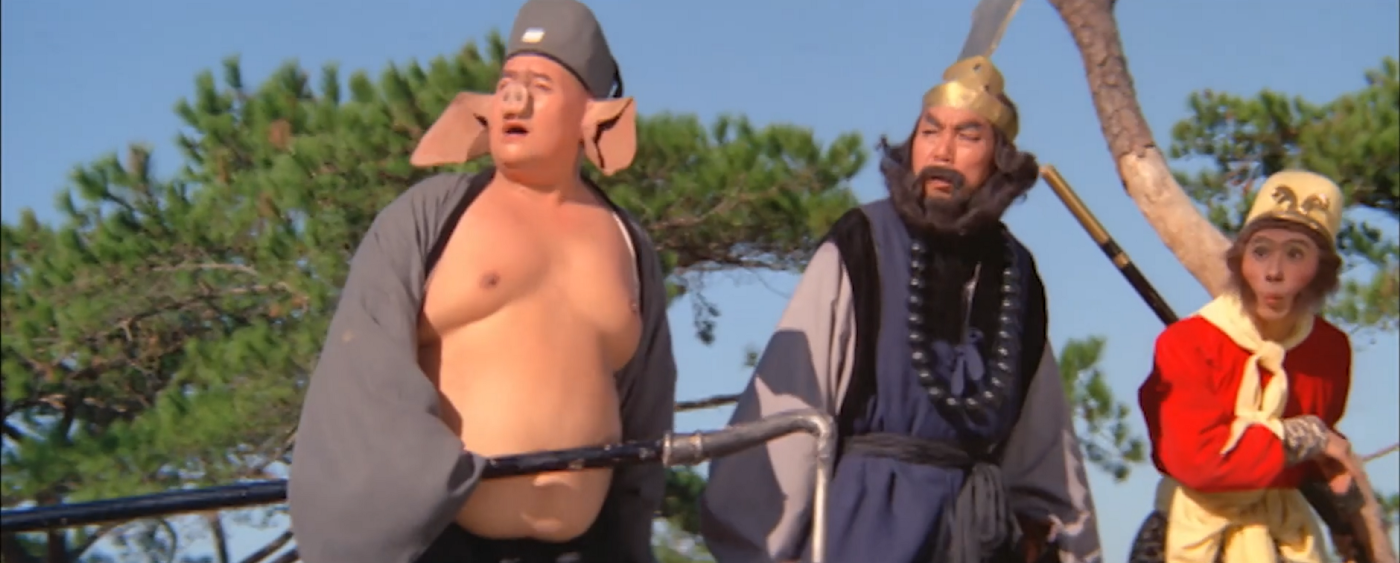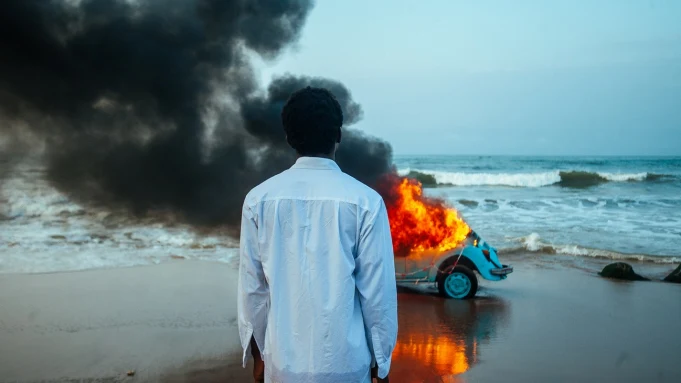
For a movie that many people might walk out on immediately, Toto Who Lived Twice is beautifully made. Directed by Daniele Ciprì and Franco Maresco in 1998, it is an anthology of three stories. They are all shot in grainy, high-contrast film, but the cinematography is stunning. The film is a study in high and low, sacred and profane, ordinary and absurd.
Toto Who Lived Twice was shot in Southern Italy. A dramatic place where the rocky terrain and scrubby vegetation are lit by harsh sunlight. Southern Italian culture is an important part of the film. The characters are not ordinary, mainstream people living in the city or the suburbs or even on farms. These are hardscrabble men and women eking out an existence in an inhospitable environment. They are deeply religious and superstitious and monitor each other for any slight infraction. They are as unforgiving as the landscape they live in.
None of the three stories are titled. They are each introduced by a Roman numeral.
I
The first story is short and simple, but it unfolds like a bizarre fever dream. It opens with a man humping a donkey and then cuts to a large group of men crammed in a public bathroom masturbating. The main character is Paletta, played by Franco Maresco himself. Paletta appears to be mentally challenged in some way and is teased and abused by the town. He has no money to visit the town’s prostitute and so steals some jewelry and eventually pays the consequences. Despite its simplicity, the story hides multiple facets.
About halfway through you realize that there are no female actresses. There are female characters, but they are all played by men. It seems likely that all of the cast was chosen from local people. The glowing skin and shiny hair of the glamorous cinema stars are replaced by the craggy idiosyncrasies of ordinary individuals.
There is hardly a moment of the film where someone isn’t masturbating or talking about sex. Everyone is constantly touching themselves or lusting after someone or something. With everyone being male, homosexual themes and ideas begin to surface, but in strange ways.
On its surface, the story is conventionally heterosexual, but we see that these sex-obsessed men are not just male or female characters, but slippery vectors of gender that shift back and forth according to the context. Every scene can be read in multiple ways depending on how you construe the “female” characters. The women in the film could be male actors playing women, or they could be male characters pretending to be women, or they could be male actors pretending to be men pretending to be women. The relationships could hetero, homo, or something more complicated.
This unstable duality of gender recapitulates the duality at the heart of the film. Just as male and female create and define each other, so do the pious and profane. The gritty lust of these people is juxtaposed with their religious zeal. All dualities are inextricably linked. Evil can not be defined or even exist without its opposite. To conceptualize one pole, you need the other.
The problem is that one end of the pole is often invisible. Evil is labeled without thought to how it functions in a duality. Such dualities are often a means of pointing a finger away from the person who uses the term and toward someone or something else. Gay and straight, good and evil, black and white are continuums that do not exist as polar opposites, but we label them as such in order to force the concepts into opposition. By labeling some people black and other people white, we ensure that the two groups are as separate and different as possible.
In Toto Who Lived Twice, the duality of the pious and the profane plays a central role. The creators and arbiters of these concepts are the Catholic Church. All three stories use Christian imagery and ideology as a framework for everything that transpires.
In the first story, Paletta is positioned in such a way as to resemble Jesus. Paletta is a pariah, an outcast who suffers at the hands of his fellow man. Eventually, we actually see him in a crown of thorns. The Romans sacrificed Jesus to purge Jerusalem of his influence. Paletta is sacrificed by the Mob to keep the peace. The Mob and the church are positioned as opposites, but in practice, they are very similar. They require money and deference and claim to protect the populace.
This tangle of opposites evokes the films of Piero Paolo Pasolini. Both Pasolini and Ciprì & Maresco mingle flesh with the spirit to fuel tense conflicts of conscience. In order to walk amongst humanity and be sacrificed for humanity’s sins, Jesus had to be human, but for the sacrifice to work, he had to also be a god. He has to occupy two contradictory positions. For Pasolini and for the makers of Toto Who Lived Twice, there is a parallel in humanity’s conflicted drives to both indulge their flesh as well as seek spiritual salvation.

II
The second story is very different from the first. It does not immediately assail you with absurdity and sex. It opens with a family sitting by a dead man lying in state. He is in his suit, on his bed, surrounded by candles. Through a series of flashbacks, we learn the story of the deceased. His name was Fefe, and his story is about how he met his lover, Pitrinu. As in the first story, all the parts are played by men, and again it destabilizes the sexuality of the characters. Each character, each situation, exists in a limbo where it can be seen in a multiplicity of ways. Sex and gender are placed in quotation marks, allowing us to consider what we are seeing in unexpected ways.
Then, just when you are getting used to the idea, it turns out that the central couple is not two male actors performing the roles of a man and a woman. They are two male actors playing male characters, one of whom is pretending to be female. Instead of seeing what looks like a male actor playing a male character paired with a male actor playing a female character, we are seeing a male actor playing a male character and a male character playing a male character who is living as a woman.
The two men are a couple, and so the implicit homosexuality of the first story becomes explicit in the second. To add to the instability, there are still what appear to be female characters being played by men in the same story.
Once it is established that these two men are in a relationship, we see that the other characters are horrified by this. Now we are watching a story that speaks directly about sexual oppression and forbidden love.
The second story is a little more involved than the first one. The second story cleverly builds on the expectations set up by the first and instead of fulfilling them, it defies them. The religious nature of the first story is transformed into a magic realist romance where our lead lovers find salvation and sacrifice in each other's arms. The ideas set out in the first story are expanded by the second and so prepare us for the third.

III
In story number three, we go right back to the shocking and absurd. It opens with an angel walking through the scraggly landscape. Suddenly he is stricken with an upset stomach and so squats behind a bush to relieve himself. The story wastes no time juxtaposing the sacred and profane.
Then it's straight into chicken fucking, murder, and rape. The last story pushes everything further. We are thrust into a violent, surreal nightmare. The narrative is fractured and we are left with a series of strange vignettes. Characters from the past two stories make appearances. Paletta and Pitrinu, both of whom were thieves in their stories, are crucified in the last one.
Along with raising the intensity, this third story is also much funnier. There are some references to Life of Brian and some ridiculous reworking of biblical stories. A foul-mouthed and thoroughly grumpy prophet named Toto is tasked with bringing Lazarus back from the dead, but Lazarus has been completely dissolved in acid by the mafia.
The final duality is expressed when Toto the prophet meets his identical twin, Toto the Mafia Don. The result being more violence. The film closes with three crosses silhouetted on a hill and an accordion player playing the theme from the first story.
Toto Who Lived Twice is the sort of movie that requires several viewings. It is a rich tangle of interrelated themes that combine in surprising ways. I was not able to find very much about the film online. The few things I did find differed wildly in their interpretations. One saw the film as being about man killing god, another saw it as a loose reworking of Pasolini’s The Gospel According to St. Matthew. The variety of interpretations speaks not only to the film’s depth, but its ability to evoke imagery and ideas outside of itself.

Seen as a whole, the three stories center on the relationship between the body and the soul. The characters’ sexual urges and sensual nature are locked in an insoluble conflict with their aspirations of spirituality. To explore such themes, the film dips into the shocking and absurd, but it is our own conflicted nature that makes us see these things as shocking and absurd to begin with. A man tugging on his penis means nothing until someone comes along and says he’s not allowed to. It is only through our own absurd ideas that we can view things in our world as absurd.

If you enjoyed this article you might also like - https://filmofileshideout.com/archives/brunello-rondis-il-demonio/



